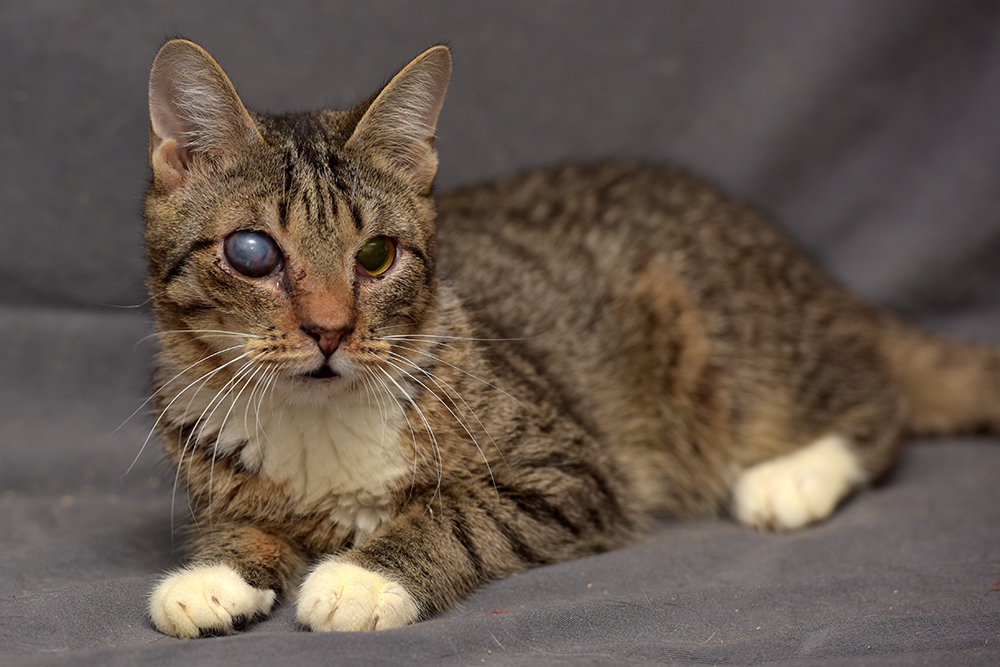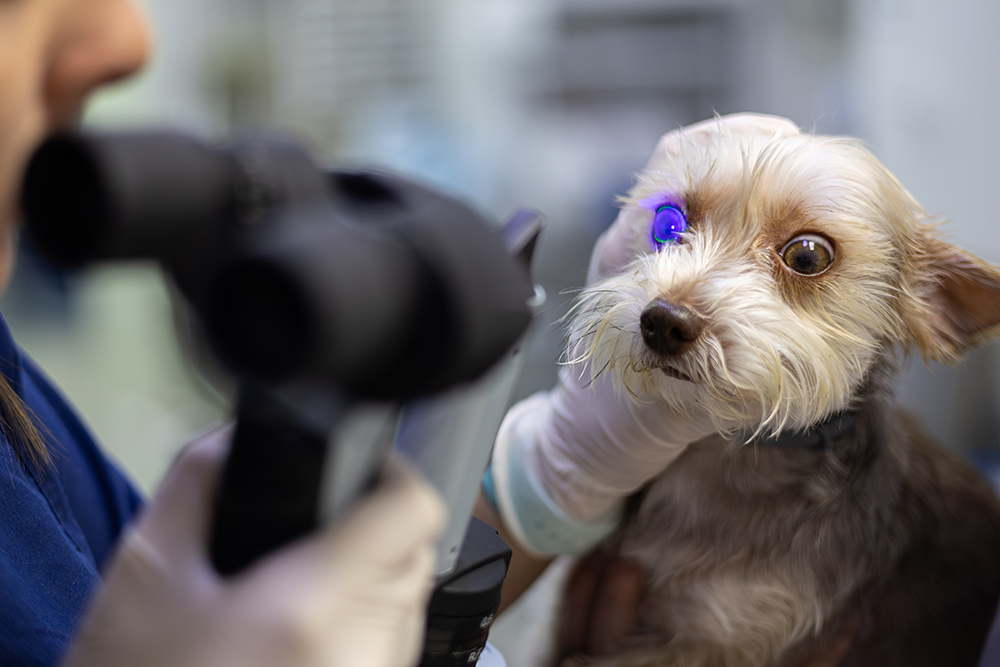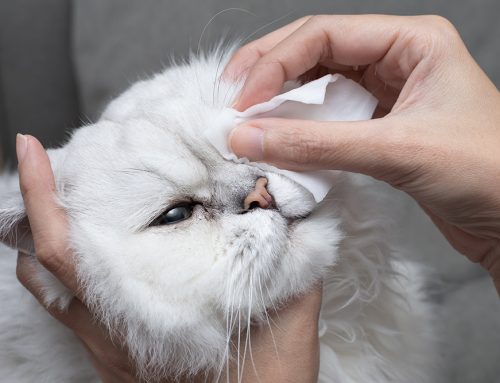Glaucoma is one of the leading causes of irreversible blindness in pets—and often progresses without obvious early symptoms. This condition arises from increased intraocular pressure (IOP), which damages the optic nerve and retina over time. While both cats and dogs can develop glaucoma, it’s particularly common in certain dog breeds and frequently presents as either an acute emergency or a slow, progressive disease.
At Veterinary Vision Center in Shreveport, Louisiana, our ophthalmology team specializes in identifying and managing glaucoma using advanced diagnostic tools and treatment protocols. With early detection and targeted care, we can often preserve vision, manage pain, and help pets maintain a high quality of life.
Understanding Glaucoma in Pets
What Is Glaucoma?
Glaucoma is a disease caused by improper drainage of fluid (aqueous humor) within the eye, leading to elevated pressure. Over time, this pressure can permanently damage the optic nerve and cause vision loss.
There are two primary types:
- Primary Glaucoma: An inherited condition commonly seen in Cocker Spaniels, Basset Hounds, and Siberian Huskies.
- Secondary Glaucoma: Develops from another eye disease such as uveitis, lens luxation, or trauma.
Explore a clinical overview of canine glaucoma for more background on pathophysiology and treatment outcomes.
Causes and Risk Factors for Glaucoma
While glaucoma can affect any pet, some are at higher risk:
- Breed Predisposition: Genetic factors play a major role, especially in dogs.
- Previous Eye Injury or Surgery: Trauma, inflammation, or complications from other eye diseases can lead to secondary glaucoma.
- Systemic Conditions: Diseases like diabetes or high blood pressure can elevate risk.
Visit Cornell’s Glaucoma Resource to learn how genetics and structure contribute to glaucoma in certain breeds.
Symptoms of Glaucoma: What Pet Owners Should Watch For
Glaucoma may initially go unnoticed—but when symptoms appear, they can escalate quickly.
Common signs include:
- Squinting or sensitivity to light
- Redness in the white of the eye
- Cloudiness or a bluish haze in the cornea
- One eye appearing larger than the other
- Behavior changes: withdrawal, reluctance to play, or bumping into objects
In acute cases, pets may display sudden, severe pain, lethargy, or vision loss—making this a true ophthalmic emergency. Today’s Veterinary Practice breaks down the urgency of acute glaucoma in pets.
Diagnosing Glaucoma in Dogs and Cats
Veterinary Examination and Testing
At Veterinary Vision Center, we use advanced diagnostics to detect glaucoma and assess its impact:
- Tonometry: Measures intraocular pressure quickly and painlessly
- Gonioscopy: Evaluates drainage angles within the eye
- Fundic Exam: Assesses damage to the optic nerve and retina
- Ocular Ultrasound: May be used to assess hidden causes or complications
Accurate measurement and early detection are key. For a pet owner-friendly summary, see Pawlicy Advisor’s guide to glaucoma in dogs.
Treatment Options for Glaucoma
Medical Management: Controlling Pressure and Pain
For many pets, eye drops and oral medications are used to reduce intraocular pressure and inflammation:
- Topical carbonic anhydrase inhibitors and beta-blockers
- Oral medications for systemic pressure control
- Anti-inflammatory therapies to reduce swelling
Administering eye medications correctly is critical for treatment success. Cornell’s guide to administering pet eye meds provides helpful step-by-step instructions for pet owners.
Surgical Options: Preserving or Relieving Vision
When medical therapy is not enough—or the eye is too damaged—surgical treatment may be recommended. At Veterinary Vision Center, we offer several advanced procedures:
- Laser Cyclophotocoagulation: Reduces fluid production via targeted laser therapy
- Anterior Chamber Shunt Placement: Promotes fluid outflow to lower IOP
- Enucleation (Eye Removal): A humane, pain-relieving solution when vision cannot be saved
Learn more about surgical outcomes in glaucoma to understand when surgery is the best option.
The ACVO’s glaucoma resource also offers practical guidance on surgical timing and expectations.
Feline Glaucoma: Different Presentation, Same Concern
Cats with glaucoma tend to show fewer outward signs than dogs, and symptoms often mimic other chronic eye conditions. Some may have subtle behavior changes or cloudiness in the eye without obvious discomfort.
For cat-specific insights, refer to Cornell Feline Health Center’s glaucoma resource.
Preventing and Managing Glaucoma Over Time
For At-Risk Pets: Genetic Counseling and Early Screening
If your pet belongs to a breed predisposed to primary glaucoma, annual eye exams starting at age 2–3 are essential. Genetic screening and early tonometry help us monitor pressure trends before symptoms develop.
For All Pets: Lifestyle and Wellness Care
- Avoid eye trauma: Protect pets from rough play or environmental hazards
- Monitor for systemic diseases: Keep diabetes, hypertension, and inflammation under control
- Stick to a consistent medication schedule: Especially after diagnosis
And for all pets—routine care matters. Early intervention is the most powerful tool we have in preserving sight.
When to Seek Immediate Care
Prompt veterinary attention is critical if your pet shows signs of:
- Sudden eye swelling or bulging
- Squinting, pawing at the eye, or visible pain
- Sudden disorientation or bumping into furniture
If you’re unsure whether it’s an emergency, err on the side of caution. Acute glaucoma is painful and can cause blindness within hours.
Your Partner in Vision Care: Veterinary Vision Center
At Veterinary Vision Center, we understand that eye issues in pets can be alarming—and complex. Whether your pet has already been diagnosed, or you’re simply noticing something “off,” we’re here to help.
Schedule an eye exam or explore our ophthalmology services to learn more about how we care for your pet’s eyes—and quality of life.








Leave A Comment